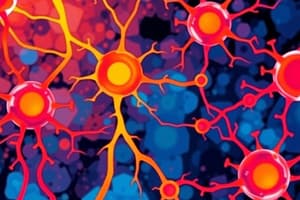Podcast
Questions and Answers
ما هي الأجزاء الأساسية للخلية العصبية؟
ما هي الأجزاء الأساسية للخلية العصبية؟
- الجذع العصبي والألياف العصبية
- المحور ونهايات المحور العصبي
- المحور والإكستريميتيز
- الجسم الخلوي والتي تحتوي على النواة والريبوسومات (correct)
ما وظيفة نهايات المحور العصبي؟
ما وظيفة نهايات المحور العصبي؟
- استقبال الإشارات من خلايا عصبية أخرى
- تغطية المحور بغلاف واقي
- إرسال الإشارات إلى خلايا عصبية أخرى أو الأنسجة (correct)
- سرعة نقل الإشارات عبر المحور
ما هو التغير السريع في جهد الغشاء الذي يسافر عبر المحور؟
ما هو التغير السريع في جهد الغشاء الذي يسافر عبر المحور؟
- الإجراء المحتمل
- الإشارة الكيميائية
- الشحنة الكهربائية
- الإشارة الكهربائية (correct)
ما هي وظيفة غلاف الميلين؟
ما هي وظيفة غلاف الميلين؟
ما هو التسمية التقنية للإشارة الكهربائية التي تستخدمها خلايا الأعصاب للاتصال؟
ما هو التسمية التقنية للإشارة الكهربائية التي تستخدمها خلايا الأعصاب للاتصال؟
ما هي الخطوة التي تلي وصول الإشارة العصبية إلى أطراف الشعاب العصبية؟
ما هي الخطوة التي تلي وصول الإشارة العصبية إلى أطراف الشعاب العصبية؟
ما هي وظيفة خلايا العصب الحسية؟
ما هي وظيفة خلايا العصب الحسية؟
ما هو دور خلايا العصب المحرك؟
ما هو دور خلايا العصب المحرك؟
ما هو تصنيف خلايا العصب التالث؟
ما هو تصنيف خلايا العصب التالث؟
ما هو عامل التحفيز أو التثبيط للخلية العصبية عند تفاعلها مع النواتج؟
ما هو عامل التحفيز أو التثبيط للخلية العصبية عند تفاعلها مع النواتج؟
Study Notes
Unraveling Nerve Cells: The Building Blocks of Our Nervous System
Nerve cells, also known as neurons, are the fundamental building blocks of the nervous system. They communicate with one another through electrical and chemical signals, allowing us to think, feel, and interact with the world around us. Like any complex structure, understanding the intricacies of nerve cells can provide valuable insights into the inner workings of our bodies and minds.
Structure of Nerve Cells
Nerve cells are unique in their structure, which consists of several specialized parts. At the core of each neuron is the cell body, or soma, containing the nucleus, ribosomes, and other cellular organelles. Neurons also feature specialized extensions:
- Dendrites: These branched appendages receive signals from other nerve cells.
- Axon: A long, thin projection that sends signals to other nerve cells or tissues.
- Axon terminals: The end of the axon where signals are transmitted to other nerve cells, muscles, or glands.
The axon is covered by a protective sheath called the myelin sheath, composed of fatty material from glial cells. The myelin sheath helps speed up the transmission of signals along the axon.
Signal Transmission in Nerve Cells
Nerve cells communicate with one another using electrical and chemical signals. The electrical signal, known as the action potential, is a rapid change in the membrane voltage that travels along the axon. This voltage change is initiated by dendrites receiving chemical signals, or neurotransmitters, released by other nerve cells.
When the action potential reaches the axon terminals, it triggers the release of neurotransmitters into the synaptic cleft, a small space between the axon terminals and the receiving dendrites of another neuron. These neurotransmitters then bind to receptors on the receiving neuron's dendrites, either exciting or inhibiting the neuron, which can lead to the generation of another action potential.
Classification of Nerve Cells
Neurons can be classified into three main types based on their structure and function:
- Sensory neurons, also known as afferent neurons, receive information from the external environment, such as touch, temperature, and vision, and transmit this information to the central nervous system.
- Motor neurons, or efferent neurons, transmit signals from the central nervous system to muscles and glands, controlling movement and physiological functions.
- Interneurons, or association neurons, are found within the central nervous system and integrate information from other neurons, playing a critical role in processing and transmitting information.
Understanding the structure, function, and classification of nerve cells is essential to understanding the complex and intricate nervous system that enables us to experience the world around us. Kandel, E. R., Schwartz, J. H., & Jessel, T. M. (1991). Principles of neural science. McGraw-Hill Education. Purves, D., Augustine, G. J., Fitzpatrick, D., Katz, L. C., LaMantia, A. S., McNamara, J. O., & Williams, S. C. (2008). Neuroscience (4th ed.). Sinauer Associates. Lichtman, J. W., & Sanes, J. R. (2014). Principles of neural development. Cold Spring Harbor Laboratory Press. Harris, S. E., & Kater, B. L. (1999). Neurobiology. Jones & Bartlett Learning.
Studying That Suits You
Use AI to generate personalized quizzes and flashcards to suit your learning preferences.
Description
في هذا الاختبار، ستتعرف على أساسيات علم تشريح الأعصاب، حيث أن الخلايا العصبية هي الوحدات الأساسية التي تشكل النظام العصبي. ستتعرف على بنية الخلية العصبية، وكيفية انتقال الإشارات بينها، وتصنيفها حسب وظائفها المختلفة.




